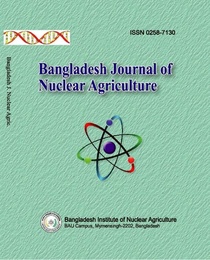DETERMINATION OF OPTIMUM ROW SPACING FOR BETTER SEED YIELD AND YIELD CONTRIBUTING CHARACTERS OF ADVANCED MUSTARD (Brassica napus L.) MUTANTS IN BANGLADESH
Abstract
A field experiment was conducted at BINA substations, Rangpur and Magura in 2018-19 to evaluate the different row spacing on the yield and yield contributing characteristics of advance mustard lines RM-03, RM-07, RM-10 along with one check variety BARI sarisha-15 during Rabi season. BARI sarisha-15 was irradiated with 700 Gy Cobalt 60 (60Co) Gamma source and advanced mutant lines M6 generation of mustard mutant (RM-03, RM-07, RM-10) were evaluated along with the check variety BARI sarisha-15 using four different row spacings viz. 20cm, 25cm, 30cm and 35cm. The experiment was laid out in split-split plot design with three replications. Among the advance lines, RM-03 produced the highest seed yield (1.60 t ha-1) followed by RM-10 (1.50 t ha-1). Among different line spacing, 20cm showed highest seed yield (1.66 t ha-1). The interaction of mutant/variety and location revealed that the yield of RM-10 was the highest (1.54 t ha-1) at Rangpur. The interaction effect of line spacing and location showed that 25cm line spacing produced the maximum seed yield (1.68 t ha-1) in Magura followed by 20 cm (1.64 t ha-1) in Rangpur. The interaction effect of mutant and line spacing showed that mutant line RM-03 at 20 cm produced maximum seed yield (1.68 t ha-1) in Rangpur. The interaction effect of mutant/variety, line spacing and location showed that RM-10 produced the highest seed yield (1.73 t ha-1) at 20cm line spacing in Rangpur followed by RM-07 (1.66 t ha-1) at same spacing.
References
BBS, 2022. Bangladesh bureau of statistics, statistical yearbook of Bangladesh, Statistics Division, Ministry of Planning, Government of the People's Republic of Bangladesh, Dhaka.
Begum, F., Rahman, Mizanur, M. and Islam, N. 2023. Effect of Seed Rate and Row Spacing on the Yield and Yield Components of Mustard in Bangladesh SSRN: https://ssrn.com/abstract=4433438.
Begum, M., Rahman, M. and Islam, N. 2005. Effect of seed rate and row spacing on the yield and yield components of mustard. MS thesis. pages-7.
FAO (Food and Agriculture Organization of the United Nations) 2021. Terra STAT database. at http://www.fao.org/agl//agll/terrastat.
FAO. 2012. Statistical year book, vol.73. FAO statistics series 119. pp. 152-154. Food and Agriculture Organization of United Nations, Rome, Italy.
Gomez, K.A. and Gomez, A.A. 1984. Statistical Procedure for Agricultural Research. 2nd Ed. A. Wiley-Intersci. Pub., pp. 130-240.
Miah, M.A.M., Rashid, M.A. and Shiblee, S.A.M. 2014. Assessment of socioeconomic impacts of oilseed research and development in Bangladesh. Final report submitted to the Agricultural Economics and Rural Sociology, BARC, Farmgate, Dhaka.
Myers, L.R. 1995. Uses of canola. Canola, 1nc. 8910 Purdue Road, Suite 150, Indianapolis, IN 46 268.
Shahidulla, M., Islam, U., Karim, M.A. and Hussain, M. 1997. Row and plant spacing management in mustard. Bangladesh J. Sci. Ind. Res. 32(3):414-417.
Wahhab, M.A., Mondal, M.R.I., Akbar, M.A., Alam, M.S., Ahmed, M.U. and Begum, F. 2002. Status of oil crops production in Bangladesh. Oil Seed Res. Center, Bangladesh Agril. Res. Inst., Joydebpur, Gazipur, pp. 4-62.
-
Download



